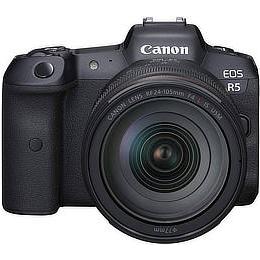canon eos r5

Supported Versions
Requires Dragonframe 4.3.4 or newer. (5.x, 2024.x, 2025.x are newer).
Live View
The Canon EOS R5 provides a live view via its USB connection. The live view size is 960 x 640. If you have Canon's stop motion animation firmware, the live view is 1920 x 1280.
Stop Motion Animation Firmware
Canon offers a special stop motion animation firmware with HD live view, focus peaking, aperture lock, and focus programming. (Availability varies by region.)
More Info
Camera Settings
Dragonframe controls the Canon EOS R5 ISO, shutter speed, aperture (with digital lens), image quality, and size.
Product Info
You can find the Canon EOS R5 manual and specifications at the Canon website.
Manual Lens to Avoid Flicker
To avoid any potential flicker that can be caused by electronically controlled aperture lenses, please consider using a fully manual aperture lens.
(If you have the Canon stop motion animation firmware and a Canon RF lens, you should not get flicker.)
Learn More about Aperture Flicker
Setup Instructions
- Create a new scene or open an existing scene. (Dragonframe will not connect to your camera unless you have a scene open.)
- Power your camera by AC power if possible, or use a fully charged battery.
- Close any other applications that might connect to your camera.
- - For macOS, Open Image Capture, select your camera, then in pop up area in lower-left select Connection camera opens: No application. (See Picture)
- Make sure Dropbox is not a client of the camera.
- You may need to quit Google Backup and Sync, since it can interfere with the camera even if you turn off syncing.
- If you have anti-virus software, white-list Dragonframe so that it may access your camera.
- Set the Mode Dial to Manual (M).

- Set Auto Power Off to OFF.
- Set Auto rotate to OFF.
- Set Lens to Auto Focus and disable Image Stabilization.
(This step applies to digital lenses. However, we recommend you use a manual aperture lens as described above.) - You may need to remove the CF/SD memory card.
- Set SET UP 2 : Power Saving : Viewfinder off to Disable.
(Otherwise, the image will randomly shift between shots.) - Turn OFF the camera's WiFi connection, if it has one. Otherwise it can interfere with the USB connection.
- Connect your camera to the computer with an appropriate USB cable.
- Proceed to the Cinematography workspace to adjust the camera exposure settings, check focus, and take test shots.
